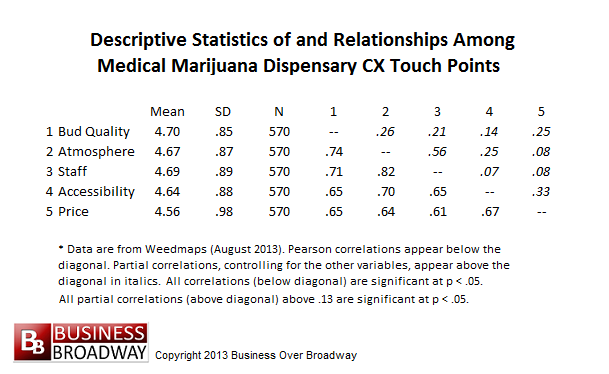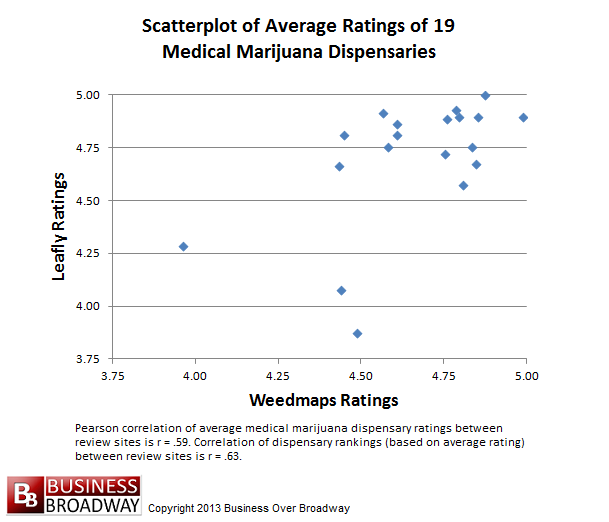
Figure 1. Word cloud for verbatim comments about medical marijuana dispensaries from 1000+ customers/patients. Data are from Leafly and Weedmaps.
The recreational marijuana industry is about to open for business. What can this emerging industry learn from the field of customer experience management? Service is still important.
Washington and Colorado became the first states to legalize marijuana for recreational use. Washington state recently adopted rules to help govern this new recreational marijuana system, including rules related to location of stores, production caps, the size of growing facilities and others. The state is expected to license 334 marijuana stores statewide.
State officials believe that recreational marijuana will gain market share over medical and illicit-market marijuana. The legal recreational marijuana stores will do so by providing a better customer experience on such factors as price, quality and convenience.
Medical Marijuana Dispensary Ratings
To better understand the importance of these non-marijuana factors to the overall marijuana store experience, I looked to publicly available customer ratings of medical marijuana dispensaries that have been in business for several years in Washington state. Several online review sites for medical marijuana dispensaries allow customers/patients to provide confidential ratings of their experience with their medical marijuana dispensary. I used two review sites, Weedmaps and Leafly, to cull customer feedback ratings about different customer experience touch points.
Weedmaps allows patients/customers to provide ratings across five areas: Bud Quality, Atmosphere, Staff, Accessibility and Price. Leafly allows patients/customers to provide ratings on three areas: Medication, Service and Atmosphere. For each of these two review sites, customers provide ratings on a scale from 1 (low) to 5 (high). Additionally, each site also allows customers/patients to provide open ended comments about their experience. I manually transcribed the ratings and verbatim comments directly from the respective sites into a database for further analysis. In August 2013, I selected 20 medical marijuana dispensaries in the Seattle region that had, at least, around 30 customer reviews. In total, we have over 1000 patient ratings (Weedmaps: N = 570; Leafly: N = 446) for 20 medical marijuana dispensaries. Nineteen dispensaries appear in both data sets.
The Customer Experience is about More than the Marijuana
Using the verbatim comments from the 1000+ responses, I created a word cloud to understand the types of words being said about the customer experience in medical marijuana dispensaries. A word cloud is a collection of words individually weighted by size that reflect the frequency of occurrence of that word within the body of the text (see wikipedia.org). The word cloud for the current study appears in Figure 1. While the medicinal aspects of the marijuana are mentioned often (“Meds,” “Strains,” “Bud”) by customers, customers are also concerned about the service aspects of their experience (“Place,” “Staff,” “Friendly,” “Helpful,” “Price,” “People,” “Service” and “Location”). Clearly, the customer experience is about more than the marijuana.
Medical Marijuana Dispensaries Receive High Ratings (No Pun Intended)
The descriptive statistics of and relationships among CX touch points for the ratings from Leafly appear in Table 1. The descriptive statistics and correlations for Weedmaps CX touch points appear in Table 2. As we see in Tables 1 and 2, customers/patients give very high ratings across each of the CX touch points. On a scale from 1 to 5, the average ratings are all above 4.55. Patients give the highest ratings to marijuana quality (e.g., “Medication” and “Bud Quality”). Patients give the lowest ratings to Atmosphere and Price.
Service-Related CX Touch Points are Important to Medical Marijuana Quality
Looking at the correlations among the metrics in Table 1, we see that the correlations among the three CX touch points are high (all above .70). The upper portion of table contains the partial correlations among the three CX touch points (controlling for the other variable). Even after controlling for the other variable, we still see statistically significant relationships among the CX touch points. Patients who gave low ratings on service quality also gave low ratings on the medication and atmosphere.
We see similarly high correlations among the CX touch points in Table 2. The partial correlations between two variables (controlling for the effects of the other three variables) appear in the top part of Table 2. We still find that marijuana quality is significantly related to service-related touch points (Staff and Atmosphere); patients who give lower ratings about Staff and Atmosphere also give lower ratings about the quality of the marijuana (Bud Quality) compared to patients who give higher ratings about Staff and Atmosphere.
Next, I wanted to determine if these two review sites give provide similar ratings for the 19 dispensaries common to both. First, I simply calculated the average score for each dispensary across all CX touch points (given the high correlation across the metrics, an overall score makes sense) for each review site. I then correlated these overall ratings across the two review sites. The correlation was r = .59. This correlation suggests that these two review sites (Leafly and Weedmaps) provide similar ratingsabout the quality of the dispensaries. The scatterplot of this relationship appears in Figure 2 and illustrates the validity of the ratings from these two review sites.
Summary of Findings
This initial set of analyses reveals some interesting implications for the recreational marijuana industry:
- Marijuana stores will likely receive high customer ratings. I suspect high ratings will decrease as the recreational marijuana industry matures.
- Service-related factors of marijuana stores will have a significant impact on the ratings about the quality of the marijuana. Deliver better service at a better price and you will likely improve the ratings about the quality of the marijuana.
- While there is some evidence that online review sites can provide reliable, valid and useful information about the quality of marijuana stores, there seems to be a halo effect seen in the ratings (little distinction across CX touch points; some customers see everything as good; others see everything as bad). In this situation, it is difficult to tease out the role of any specific touch point.
Next Steps
While the findings of this initial set of analyses are interesting for the recreational marijuana industry, more systematic research can be done to extend the current findings. Initially, this research can be conducted using medical marijuana dispensaries as the target and generalized to the legal recreational marijuana industry. When recreational marijuana stores open up, this systematic research can be extended to that sample.
1. Measures different customer touch points
Online review sites only allow for a few CX touch points to be rated. In my research, I found that around seven CX touch points provide a comprehensive picture of the customer experience. For the marijuana industry, I suspect the following touch points will be important:
- Ease of doing business
- Product quality
- Pricing
- Customer service
- Hours of operation
- Communication from company
- Company’s direction and future products
2. Measure customer loyalty
While the online review sites provided insights about how the CX touch points are related to each other, they tell us nothing about how they are related to customer loyalty. Customer loyalty is the degree to which customers experience positive feelings toward and exhibit positive behaviors toward a company/brand. Measuring different types of customer loyalty will help recreational marijuana stores understand how to increase customer lifetime value and company value in three different ways. To be successful, companies need to design a customer experience that makes customers want to 1) tell their friends, 2) buy more and 3) become a long-term customer.
For the marijuana industry, the following loyalty metrics could be used:
- Likelihood to recommend
- Likelihood to buy again
- Likelihood to buy different types of products
- Likelihood to buy from competitors
Summary
Analysis of publicly available data on medical marijuana dispensaries shows that different CX touch points are related to each other. Dispensaries that receive higher ratings on service aspects of the relationship also receive higher ratings on the quality of their medical marijuana.
In such a unique, emerging market as the marijuana industry, differentiating yourself from the competition might be difficult; customers will likely put up with poor service to purchase something that was recently unobtainable (legally). As the market matures and more marijuana stores open for business, however, customers will more likely be swayed by factors other than the quality of the marijuana. To be successful, marijuana store owners will need to understand how to distinguish themselves from the competition.
I proposed two areas of research (initially in the medical marijuana industry and then the recreational marijuana industry) that could help shed light on how the recreational marijuana industry could be better prepared to deliver a great customer experience: 1) Measure different CX touch points and 2) Measure customer loyalty. By understanding the relationship among these different customer metrics, recreational marijuana stores will understand what drives customer loyalty; they will be in a better position to design the optimal customer experience that ensures customers recommend you to their friends, buy different products from you and stay with you.
* I’d like to thank Stephen Foster for his assistance in creating usable data sets from the online review sites.






